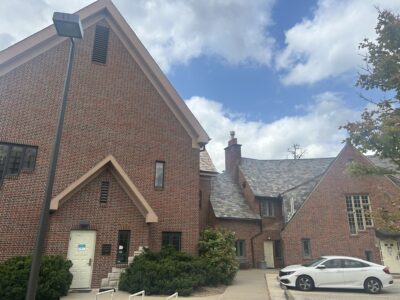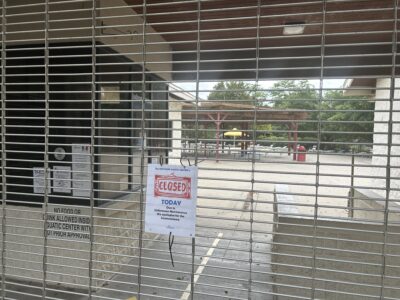To mitigate serious floods, Douglas County leaders hear, they’ll have to look closely at development and soil health

photo by: Contributed
A screenshot of drone footage shows the severe flooding in a rural Douglas County neighborhood that occurred on Aug. 1, 2019. The Washington Creek, where the floodwaters came from, sits within the tree lines behind their homes.
As Lawrence expands to the south with projects like the proposed New Boston Crossing, the landscape in its urban growth area is expected to change quite a bit with new residential and retail development.
But five years ago, the landscape southwest of Lawrence changed in a much more unexpected — and frightening — way.
At the end of July 2019, 8 to 10 inches of rain fell over the course of just eight hours and Washington Creek, which winds its way north from Lone Star Lake to the Wakarusa River, overflowed. The rural neighborhood nearby turned into a muddy swamp, and more than 100 homes were damaged.
Local leaders obviously don’t want those two types of changes happening in the same place, at the same time. They also want to protect the rural residents living in the county’s watersheds now. And to do that, a consultant says they’ll need to be smart about where growth is allowed — and take a close look at the health of the county’s soils.
On Wednesday, Douglas County commissioners were presented with a study from Stantec about potential flood prevention measures for Washington Creek, taking into account both existing and future development. The Kansas Department of Agriculture engaged the firm, which provides engineering, architecture and environmental consulting, to investigate the increased flood risk in Kansas and identify flood risk mitigation solutions around the state, including the watershed in the urban growth area south of Lawrence.
That 2019 flood was a topic of discussion at the commission’s meeting. While it affected multiple watersheds, the Washington Creek watershed from Lone Star Lake to the Wakarusa River was where the county experienced the most flooding.
It’s clear from the details that this flood was a rare event. Had the rain fallen over 24 hours, it would have approached the 100-year rainfall event threshold used to define Douglas County’s FEMA floodplain maps, the maps that show a community’s flood risk zones. However, because the rainfall actually occurred within just eight hours, historical data suggests the storm was comparable to a 500-year flood event, meaning it’s a flood that has just a 0.2% chance of occurring in any given year.
While floods on this scale might not happen often, Stantec principal Will Zung said this is part of a bigger picture of flood mitigation practices throughout Kansas.
Even in smaller flooding events, according to the meeting agenda materials, there are homes and properties in the watershed that are frequently affected, and several roads have been impassable during flash floods.

photo by: Douglas County Public Works
Flood waters force the closure of Route 458 west of U.S. Highway 59 after heavy overnight and morning rainfall, Thursday, Aug. 1, 2019.
And the challenges of flooding have been brought up repeatedly as developers look to expand south of Lawrence. As the Journal-World has reported, the New Boston Crossing project proposed just south of the South Lawrence Trafficway raised concerns among some Lawrence residents and planning leaders because of its proximity to the Wakarusa River.
“Honestly, I cannot get past growing into a floodplain,” said one member of the Planning Commission, Sharon Ashworth, at a meeting in February. “I don’t think we should be growing into the floodplain. That’s not where our development should go. We are bounded by that, and I think we have to respect the floodplain.”
Stantec’s study takes that approach for the Washington Creek watershed. It suggests that because the watershed is mostly rural right now and has a large amount of natural vegetation along its waterways, preserving the floodplain as development happens will help direct growth to safer areas with lower flood risks and reduce negative effects downstream. Plan 2040 and the Lawrence development code have set priorities to limit development in the riparian corridor — or land and waterways adjacent to a larger body of water — indicating that the community currently has interest in this.
In addition to the damage they cause to properties, floods can carry pollutants and sediment, which can settle and disrupt fragile ecosystems. They can also reshape the landscape, creating more impervious surfaces and compacting once-healthy soils.
The need to restore and improve soils is a big takeaway in Stantec’s study. Healthy soils improve infiltration of water, reduce runoff, lower flood peaks and enhance drought resilience.
Some of the practices Stantec suggests in its report include maintaining living roots in the soil to preserve structure and fertility, minimizing disturbances to the soil and maximizing soil cover.
County Commissioner Karen Willey said Wednesday that soil health practices are not greatly utilized on Douglas County’s agricultural lands. Willey asked if there was a way for regenerative agricultural practices such as cover crops, no-till or rotational grazing to be modeled in the study.
Zung said that use of cover crops is a young science, but he emphasized that clay soil can be prone to flooding.
Clay soil has a high capacity for storing water, but low drainage. These heavy clay soils hold onto water for a long time and can eventually leave yards, gardens and other landscapes full of standing water.
Commissioner Shannon Reid asked Zung about what the agriculture department intended to do with these reports statewide, and if these reports would lead to some potential statewide policy opportunities. But Zung said that it’s up to local governments to decide what to do with the data.
Zoning and Codes Director Tonya Voigt said that the county first would like this to be an educational tool for anyone who is living in this watershed now.
“Just having the knowledge is maybe the first step,” Voigt said. “This is also a small step in a much bigger picture. This is the first recent hydraulic study that we’ve done on a watershed, so the next one that we hope to do would be Wakarusa.”
“We would take the information from the hydraulic study from Wakarusa and Washington Creek and all the tributaries that feed into the Wakarusa Coal Creek,” Voigt said. “A lot of those creeks affect a lot of unincorporated landowners, and then, come up with some ideas, tools, solutions (and) having a great picture. This is just a very small step.”

photo by: Mike Yoder
Flood waters fill Naismith Valley Park at 27th Street in southern Lawrence, Thursday, Aug. 1, 2019.






